Veteran’s Testimony – William G. Garner 557th Medical Hospital Ship Platoon

Photograph of Private William G. Garner, ASN 34570663, while in training at Fort Sam Houston, San Antonio, Texas, where he was assigned to the 453d Medical Company.
Introduction:
William G. Garner was born July 2, 1906 in Forsyth County, Georgia, to James J. Garner and Martha M. Barrett. He had 7 siblings; 2 brothers – James H. and Robert G., and 5 sisters – Mary E., Sallie J., Clemmie H., Effie M. and Martha A. Garner.
His main occupation was being a general farmhand, developing skills while on the job, and conducting related activities such as planting, cultivating, and harvesting cotton, corn, beans, peanuts, watermelons, and miscellaneous vegetables. William also drove a tractor for breaking ground, plowed with mules and horses, and performed various carpentry jobs on houses, barns, sheds, and chicken houses, for either his family or neighbors.
Although he just completed first grade at school and only attended the institution until 1914, he was a very smart man. During his 20 odd years working as a farmhand, he often had to help his father who was a share cropper at the time.

Photograph illustrating the 557th Medical Hospital Ship Platoon. The 14 Enlisted Men are fooling around and pause for a photo taken during some liberty time around the end of the war, since many of them wear Class A uniforms adorned with multiple ribbons.
William Garner was a very patriotic man and a true American. Following the attack against Pearl Harbor that rocked the nation, he felt that it was his duty to do what he could to help his country. After the United States went to war, William first registered for Selective Service with the Fulton County Selective Service Board # 15. He first tried to join the United States Marine Corps in 1942, but they told him he was too old (already 36). Furthermore he also suffered from asthma!
He then tried the United States Army and wisely didn’t tell them about asthma. During the interview and preliminary tests the Army told him his age wouldn’t prevent him from being an Aidman in a hospital.
Induction:
William G. Garner was finally inducted in the Army of the United States on November 3, 1942, and effectively entered into active service November 17, 1942 at Fort McPherson, Atlanta, Georgia (Reception and Reclassification Center; total acreage 371; troop capacity 335 Officers and 5,917 Enlisted Men –ed), receiving Army Serial Number 34570663. Following Basic Training he graduated as a MOS 521, and would later function as a Medical Aidman (MOS 657) throughout the remainder of the war.
Assignment:
William went through Basic Training at Fort Sam Houston, San Antonio, Texas (Military Reservation; total acreage 23,592; troop capacity 719 Officers and 25,825 Enlisted Men –ed), where he initially joined the 453d Medical Company. After successfully completing his training Private William Garner was assigned to the 557th Medical Hospital Ship Platoon.

Private First Class William G. Garner engaged in KP or other detail …
The 557th Medical Hospital Ship Platoon was officially activated at Camp Stoneman, Pittsburg, California (Staging Area for the San Francisco Port of Embarkation; total acreage 3,242; troop capacity 2,604 Officers and 35,607 Enlisted Men –ed), on February 25, 1943. The unit’s Commanding Officer was Captain Louis G. Kaplan, MC, US Army.
Organization:
The organization was based on T/O 8-534 dated December 21, 1942, authorizing a strength of 7 Officers, 1 Warrant Officer, 20 ANC Officers and 60 Enlisted Men. The new organization was however under strength only comprising 2 Medical Officers – 1 Dental Officer – 5 ANC Officers – and 22 Enlisted Men. An amended T/O 8-534 for a Medical Hospital Ship Platoon was introduced in 1944, allowing for separate Medical Hospital Ship Platoons consisting of either 25, 50, 75, 100, 250, or 500-bed units, with manpower strength varying from approximately 1 Officer and only 4 EM (25-bed unit) to 6 Officers and 45 EM (500-bed unit). Additional personnel was required with each increase in patient capacity.
These units provided medical care for patients being evacuated on hospital ships, regular cargo or transport ships on their return trip to their Port of Embarkation/Debarkation, and were in fact supplementary to the permanently assigned medical personnel on board of the transport vessel. This is the reason why some of these Platoons operated on different ships and at different locations.
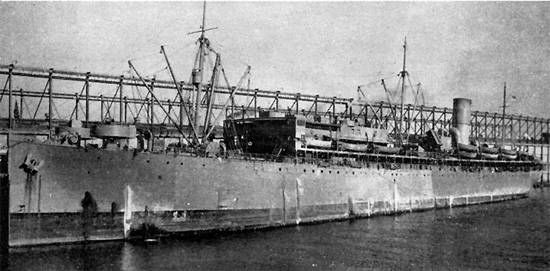
Photograph illustrating USAT “Etolin” the vessel which carried the 557th Medical Hospital Ship Platoon to Nouméa, New Caledonia October 26, 1943.
(as per T/O 8-537 dated April 1, 1942 a Medical Hospital Ship Company consisted of 10 Medical Officers, 2 Dental Officers, 1 Warrant Officer, 35 ANC Officers, and 99 Enlisted Men, based on a capacity of 500 patients. A separate T/O 8-538 dated October 27, 1942 was introduced for the Medical Ambulance Ship Company with an authorized strength of 9 Officers, 1 Warrant Officer, 20 ANC Officers, and 76 Enlisted Men, the required personnel to care for 500 patients –ed).
Training:
An initial training program was immediately begun following activation. Apart from basic medical duties the different skills included Medical and Surgical Services, but no specialties such as Roentgenological – Dental – or Laboratory services, as the latter subjects did not apply to Hospital Ship Platoons.
William Garner took the Medical Department Basic Training (MOS 521) intended for non-specialists which included such topics as; Articles of War & Army Regulations (6 hours); Organization of the Army (7 hours); Organization & Functions of the Medical Department (7 hours); Military Discipline, Customs & Courtesies (8 hours); Personal & Sex Hygiene (8 hours); Military Sanitation (28 hours); First Aid (8 hours); Dismounted Drill (46 hours); Extended Order Drill (6 hours); Interior Guard Duty (7 hours); Physical Conditioning (27 hours); Equipment, Clothing & Shelter Pitching (14 hours); Safeguarding Military Information (5 hours); Knots & Lashing (4 hours); Individual Security, Scouting & Patroling, Use of Cover & Concealment (16 hours); Hasty Entrenchment & Shelter, Camouflage (14 hours); Hand-to-Hand Combat (8 hours); Defense against Air & Parachute Attack (8 hours); Defense against Chemical Attack (12 hours); Defense against Mechanized Attack (8 hours); Demolitions (4 hours); Antipersonnel Mines & Booby Traps (8 hours); Mines & Mine Fields (8 hours); Infiltration Course (2 hours); Map & Aerial Photograph Reading (12 hours); Marches & Bivouacs (72 hours); Night Operations (52 hours); Army Orientation Course (16 hours); Transportation of Sick & Wounded (14 hours); Anatomy & Physiology (15 hours); Nomenclature & Care of Organizational Equipment (8 hours); Field Medical Records (7 hours); Emergency Medical Treatment (76 hours); Treatment of Gas Casualties (10 hours); Medical & Surgical Nursing (29 hours); Materia Medica & Pharmacy (7 hours); Heavy Tent Pitching (12 hours); Troop Movements by Motor and by Rail (4 hours); Communications in Combat (10 hours); Field Rations (2 hours); Employment of Medical Field Units (82 hours); Inspections & Tests (52 hours); Processing (16 hours); Open Time (64 hours).

Photograph of Staff Sergeant Harold E. Everett and Private First Class William G. Garner, during leave in the European Theater, in 1945.
Following Medical Basic Training, Private William Garner followed more lectures and courses, making him a Medical Aidman, allowing him to perform a wide number of duties (MOS 657 applied to servicemen such as Hospital Orderlies, Litter Bearers, Ambulance Drivers, Medical Aidmen, and Navy Corpsmen).
First Operations Overseas:
Pacific Theater
June 11, 1943 > Personnel of the 557th Medical Hospital Ship Platoon embarked on the S/S “Puebla” for its first mission overseas. Departure from the Port of San Francisco took place the same day. Private W. Garner only left the Zone of Interior on June 18, 1943 for the Pacific Theater, where he arrived on July 6. He would later join his unit in New Caledonia.
As a Medical Aidman, William would perform routine medical duties in wards of Hospital Ships (and other vessels) while caring for patients. He took temperatures, pulse readings, bathed and fed patients, and gave them medicines. He would also assist Medical Officers in caring for the patients’ needs.
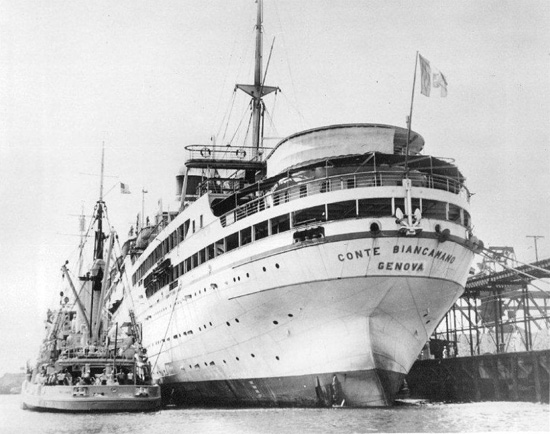
Photograph illustrating the Italian liner “Conte Biancamano”, eventually converted into a troop transport and redesignated USS “Hermitage”, AP-54, which carried the personnel of the 557th Medical Hospital Ship Platoon from Nouméa, New Caledonia, to Milne Bay, New Guinea, April 5-6, 1944.
July 8, 1943 > The organization arrived in New Caledonia. Upon arrival staff and personnel were attached to the 9th Station Hospital for quarters and rations. Roughly halfway between New Zealand and the Solomon Islands, New Caledonia (French colony, rallied to the Free French –ed) would emerge as the center of medical activity for the area including more hospitals than anywhere else in the South Pacific, such as the 8th General – 9th Station – 27th Station – 29th General – 31st Station – 52d Evacuation – 109th Station – 331st Station – 332d Station – and the 336th Station Hospitals. This is one of the reasons that personnel wounded and injured on Guadalcanal were evacuated to New Caledonia, the New Hebrides, New Zealand or Fiji. New Caledonia also housed COMSOPAC (Command South Pacific) and USAFISPA (United States Army Forces in the South Pacific Area) Headquarters, both located in Nouméa since November 1942. During its stay on new Caledonia, the 557th Medical Hospital Ship Platoon was instructed to offer medical care not only to the 9th Station Hospital but also to other units stationed on the island such as the “Americal” Division (organized in New Caledonia May 24, 1942 –ed). It should be noted that during this period the 164th Infantry Regiment (one of the 3 Infantry Regiments of the Americal Division –ed) was additionally supported by Navy corpsmen until more Army medical units arrived on the island. Many useful lessons were learned with respect to first aid in the field and treatment of ‘tropical’ diseases.
September 9, 1943 > The unit departed from Nouméa, New Caledonia, aboard the troop transport ship USS “Sea Pike” enroute for the United States.
September 26, 1943 > Arrival of the 557th Medical Hospital Ship Platoon at San Francisco POE, California, where the organization was returned for attachment to Camp Stoneman.
September 28, 1943 > Following its return to the Zone of Interior (after spending over 2 months in the South Pacific) the Platoon left on furlough.
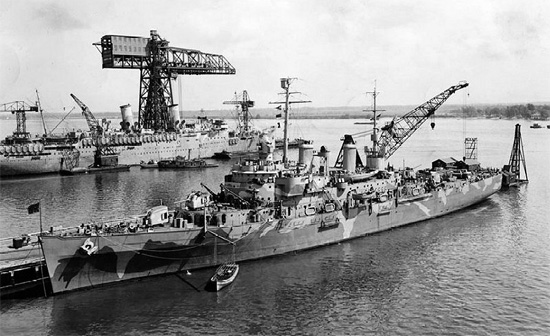
Photograph illustrating the USS “Monticello”, AP-61, another ex-Italian liner converted into a troop transport, which carried the 557th Medical Hospital Ship Platoon from Milne Bay, New Guinea to the Zone of Interior May-June 1944.The USS “Monticello” lies in the background, while the USS “Terror”, CM-5, a fleet minelayer, shows up front (photo taken in the Philadelphia Navy Yard, August 1942).
October 12, 1943 > After having been re-assembled from furlough at Camp Stoneman, California, the Platoon departed from San Francisco POE, California, aboard USAT “Etolin” (ex-USAT Matsonia, already active in WWI –ed).
October 26, 1943 > Upon its arrival the 557th was immediately attached to the 31st Station Hospital, for quarters, rations, and temporary duty.
February 4, 1944 > The Platoon Nurses were relieved from attachment to the 557th as per War Department Radiogram Order and assigned to SOSSPA (Services of Supply South Pacific Area), by Special Order No. 31, Headquarters First Island Command, APO # 502.
April 5, 1944 > The 557th departed from New Caledonia aboard the USS “Hermitage”, AP-54 (ex-Italian Liner Conte Biancamano, interned at Balboa, Panama Canal Zone, converted into a troop transport and commissioned on August 14, 1942 by the US Navy –ed) for another destination in the Southwest Pacific. She had previously left San Francisco POE March 20, 1944 bound for Nouméa, in New Caledonia. Her next destination would be Milne Bay, New Guinea and Beli Beli, Goodenough Island, all situated in the Netherlands East Indies.
April 15, 1944 > The Platoon reached Milne Bay, New Guinea (designated Base “A” –ed), where it was attached to the 47th Station Hospital, for quarters, rations, and temporary duty. New Guinea and more particularly Milne Bay were particularly hard hit by malaria and it was here that the organization and other medical units learned the power of malaria and began to adopt measures with the hope of combating and eradicating it.
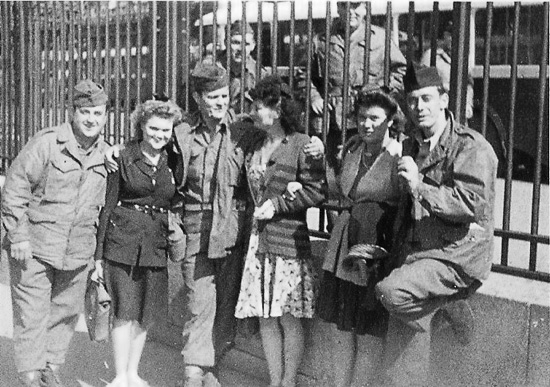
Photograph illustrating some members pertaining to the 557th Medical Hospital Ship Platoon on leave …
May 18, 1944 > The 557th was transferred to the 124th Station Hospital, in the same area, providing medical care on temporary duty basis.
May 20, 1944 > The unit packed its belongings and left Milne Bay aboard the USS “Monticello” AP-61 for the United States (ex-Italian liner Conte Grande, interned at Santos, Brazil, in February 1942, and eventually purchased by the US Government April 16, 1942, converted into a troop ship and commissioned September 10, 1942 –ed). Private William Garner was on board traveling all the way back to the Zone of Interior.
May 27, 1944 > While on her way to the Zone of Interior, she stopped at Suva, capital city of the Fiji Islands, where the personnel enjoyed some liberty.
June 10, 1944 > The Platoon arrived in Panama, Central America. It was on liberty while the ship prepared for its passage through the Panama Canal.
June 20, 1944 > The 557th reached Staten Island, New York, traveling to Camp Kilmer, Stelton, New Jersey (Staging Area for the New York Port of Embarkation; total acreage 1,815; troop capacity 2,074 Officers and 35,386 Enlisted Men –ed) following debarkation. During its stay in the ZI, the organization was attached to Camp Kilmer for quarters and rations.
June 21, 1944 > The Platoon was sent on furlough.
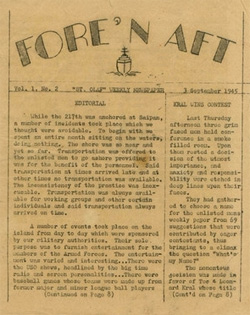
Photograph illustrating some excerpts of the “FORE ‘N AFT” weekly newspaper printed and distributed aboard USAHS “St. Olaf” during her World War Two service as a Hospital Ship. This one is Volume 1, No. 2, dated 3 September 1945.
July 6, 1944 > The 557th re-assembled after furlough and a new program was instituted. Tests and exercises were included in the program and lectures on the latest medical techniques conducted. There were rumors about a new forthcoming mission overseas.
July 14, 1944 > While at Camp Kilmer, New Jersey (Staging Area, New York POE –ed), the Platoon was re-organized under a revised T/O 8-534. The Platoon now numbered 1 Medical Officer, 1 Dental Officer, and 15 Enlisted Men (no Nurses were included –ed).
European Theater
August 12, 1944 > The depleted Platoon departed from the Port of New York leaving aboard USAHS “St. Olaf” (built in 1942, officially designated US Army Hospital Ship June 19, 1944, patient capacity 586, maiden trip August 12, 1944 from New York to the United Kingdom –ed) for a new overseas destination, supplementing the ship’s 217th Medical Hospital Ship Company. Private W. Garner made the unit’s trip to the European Theater of Operations on board this hospital ship.
August 25, 1944 > Upon arrival in Liverpool, England, instructions were received ordering the 557th to be attached to the 83d General Hospital, for quarters, rations, and temporary duty.
September 18, 1944 > The organization left Liverpool, port and city in northwestern England, Lancashire, aboard the USS “West Point”, AP-23 which had recently carried 8,112 replacements to the United Kingdom arriving in Liverpool September 14, 1944 (she had left Boston, Massachusetts, September 7, 1944 for the European Theater –ed).
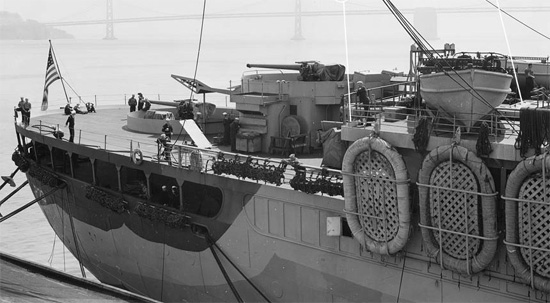
Partial photograph illustrating the stern view of the USS “West Point”, AP-23, the troop transport which carried the 557th Medical Hospital Ship Platoon from Liverpool, United Kingdom to Boston, Massachusetts, September 18-25, 1944.
September 25, 1944 > The Platoon arrived in Boston, Massachusetts, and following debarkation entrained for Camp Myles Standish, Boston, Massachusetts (Staging Area for the Boston Port of Embarkation; total acreage 1,485; troop capacity 1,298 Officers and 23,100 Enlisted Men –ed), to which it was attached for quarters and rations.
October 5, 1944 > Staff and personnel of the 557th Medical Hospital Ship Platoon departed from Camp Myles Standish by rail for another destination on the east coast.
October 6, 1944 > Following instructions relating to a new assignment, the Platoon arrived at its new Staging Area, at Charleston POE, South Carolina, which had recently become the central hub on the east coast for US Army Hospital Ships.
October 8, 1944 > The 557th left Charleston Port of Embarkation, South Carolina, aboard the USAHS “St. Mihiel (built in 1920, officially designated US Army Hospital Ship March 27, 1944, patient capacity 504, maiden trip May 10, 1944 from Boston to North Africa –ed)

Charleston, Port of Embarkation/Debarkation, South Carolina. Photograph illustrating WC-54 3/4-Ton Ambulances and empty Litters with Blankets awaiting the arrival of patients in Hospital Ships (photo taken at Charleston POE in January 1944).
October 23, 1944 > The organization arrived at Avonmouth, a port and suburb of Bristol, England, and after re-assembly and briefing departed by rail to Malvern Wells, England, where it was attached to the 96th General Hospital (NP), for quarters and rations.
Enlisted Men’s Roster (October 1944)
Staff Sergeant George A. Tripp
Sergeant Merle G. Capps
Sergeant Charles S. Damoce
Sergeant Clarence C. Daniels, Jr.
Sergeant Eugene H. Farley
Sergeant James F. Hatly
Sergeant Henry Lundin
Corporal Edward E. Ergang
Technician 5th Grade Burke L. Bridwell
Technician 5th Grade Harold E. Everett
Technician 5th Grade William D. Vimont
Private First Class Verl M. Bryce
Private First Class William G. Garner
Private First Class Edward E. McGee
Private First Class Russell Reinfenrath
Private First Class William Thompson
Private First Class Sid Turner
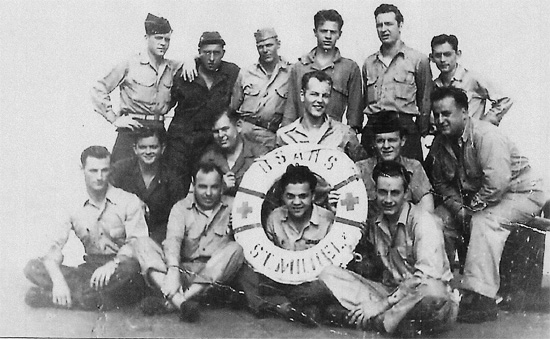
Photograph illustrating the Enlisted personnel of the 557th Medical Hospital Ship Platoon aboard USAHS “St. Mihiel” which carried the Platoon from Charleston, South Carolina to Avonmouth, United Kingdom, in October 1944.
Bottom Row L-R: Pfc. Russel Reinfenrath, Sgt. Clarence G. Daniels Jr., Sgt. Charles S. Damoce, Cpl. Edward E. Ergang
Second Row L-R: Pfc. William Thompson, Sgt. Eugene H. Farley, Tec 5 William D. Vimont, Tec 5 Burke L. Bridwell, Pfc. Sid Turner
Top Row L-R: Sgt. James F. Hatly, Pfc. Verl M. Bryce, Pfc. William G. Garner, Pfc. Edward McGee, Tec 5 Harold E. Everett, Sgt. Merle G. Capps
November 9, 1944 > Ending its short stay in the United Kingdom, the unit entrained from Malvern Wells to Liverpool, England, at 0700 hours, reaching its destination at 1600 hours the same day. After a short processing, the staff and personnel boarded the USS “West Point”, AP-23, at 1630 hours, November 9, 1944.
November 18, 1944 > The USS “West Point” arrived at Newport News, Virginia at 1800 hours and following a short briefing the personnel entrucked to Camp Patrick Henry, Oriana, Virginia (Staging Area for the Hampton Roads Port of Embarkation; total acreage 1,649; troop capacity 1,621 Officers and 22,916 Enlisted Men –ed), where it arrived around 2230 hours. The unit was subsequently attached to the Post Station Hospital for quarters and rations.
November 25, 1944 > After having been duly processed and quartered, Officers and Enlisted personnel were authorized a well-earned three-day leave.
November 28, 1944 > The Platoon re-assembled at Camp Patrick Henry awaiting further instructions.

Photograph illustrating the USS “General George O. Squier”, AP-130, one of the transports that carried the Platoon from the continental United States to the European Theater of Operations in 1945.
December 22, 1944 > The 557th initially staged at Camp Patrick Henry and eventually entrained to Charleston POE, where it departed for another sea voyage to the United Kingdom.
The 557th Medical Hospital Ship Platoon made the following overseas trips in 1945, crossing the Atlantic Ocean several times on its way either to the United Kingdom or France.
January 2, 1945 > Arrival in England, United Kingdom.
January 10, 1945 > Departure from the United Kingdom.
January 21, 1945 > Arrival in New York, United States Zone of Interior.
January 24, 1945 > Departure from New York, United States Zone of Interior.
January 30, 1945 > Arrival in Scotland, United Kingdom
February 16, 1945 > Departure from Scotland, United Kingdom.
February 25, 1945 > Arrival in New York, United States Zone of Interior.
March 10, 1945 > Departure from New York, United States Zone of Interior.
March 17, 1945 > Arrival in England, United Kingdom.
April 26, 1945 > Departure from Scotland, United Kingdom.
May 4, 1945 > Arrival in New York, United States Zone of Interior.
June 8, 1945 > Departure from New York, United States Zone of Interior.
June 16, 1945 > Arrival in Le Havre, France.
July 13, 1945 > Departure from Le Havre, France.
July 20, 1945 > Arrival in Boston, Massachusetts, United States Zone of Interior.
September 5, 1945 > Departure from New York, United States Zone of Interior.
September 7, 1945 > Arrival in Atlanta, Georgia, United States Zone of Interior.
While serving with the 557th Pfc William G. Garner traveled on the following ships: S/S Puebla, USS Sea Pike, USAT Etolin, USS Hermitage (AP-54), USS Monticello (AP-61), USS West Point (AP-23), USAHS St. Olaf, USAHS St. Mihiel, USS General George O. Squier (AP-130), RMS Queen Mary, S/S Ile-de-France, RMS Mauretania, and RMS Aquitania.
Campaign Awards – Pfc William G. Garner
New Guinea (24 January 1943 > 31 December 1944)
awarded by War Department, General Orders # 40, dated 1945
Personal Decorations – Pfc William G. Garner
Good Conduct Medal
American Service Medal
Asiatic Pacific Service Medal (with 1 miniature bronze star)
European African Middle Eastern Service Medal
Total Length of Service – Pfc Wiliam G. Garner
2 Years, 10 Months, 7 Days
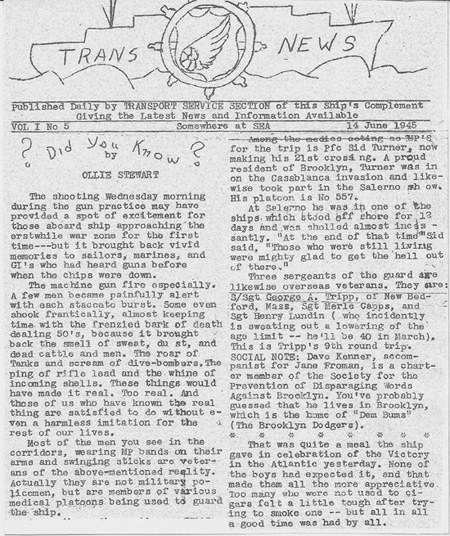
Photograph illustrating excerpts of “Trans News”, the daily news bulleting published by the 557th Medical Hospital Ship Platoon while at sea. This copy is Volume I, No. 5, dated 14 June 1945.
Private First Class William G. Garner, ASN 34570663, was separated from the service, receiving his Honorable Discharge at Fort McPherson, Atlanta, Georgia, 9 September 1945. The main reason was his age (over 35 years old); he was issued the lapel button, and left the service with an ASR score of 54 points.
After the war he opened his own gas station and auto repair shop in Atlanta. He also taught himself TV and radio repair and started a business on the side. William died of an asthma attack in 1978.
We are particularly indebted to Jim Adams who generously offered to provide us with copies of vintage documents and photographs from his Great Uncle Private First Class William G. Garner (ASN:34570663) who served with the 557th Medical Hospital Ship Platoon from November 1942 to September 1945. Thank you so much.
